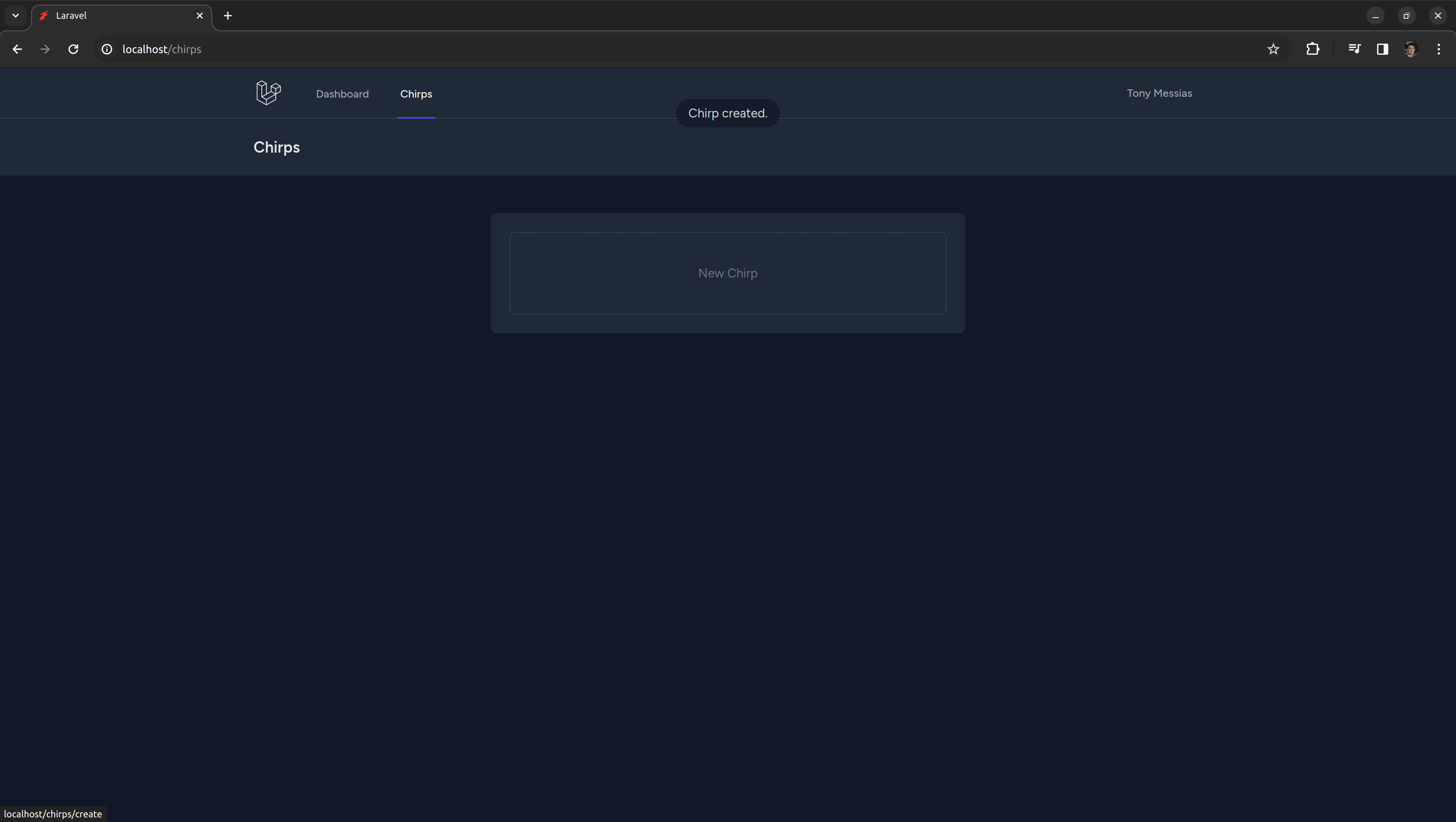02. Creating Chirps
Introduction
Let's allow users to post short messages called Chirps.
Models, migrations, and controllers
To allow users to post Chirps, we'll use migrations, models, and controllers. Let's briefly cover those concepts:
- Models provide a powerful and enjoyable interface for you to interact with the tables in your database.
- Migrations allow you to easily create and modify the tables in your database. They ensure that the same database structure exists everywhere that your application runs.
- Controllers are responsible for processing requests made to your application and returning a response.
Almost every feature you build will involve all of these pieces working together in harmony, so the artisan make:model command can create them all for you at once.
Let's create a model, migration, and resource controller for our Chirps with the following command:
php artisan make:model -mcr ChirpYou can see all the available options by using the --help option, like php artisan make:model --help.
This command will create three files:
-
app/Models/Chirp.php- The Eloquent model. -
database/migrations/<timestamp>_create_chirps_table.php- The database migration that will create the database table. -
app/Http/Controller/ChirpController.php- The HTTP controller that will take incoming requests and return responses.
Routing
We will also need to create URLs for our controller. We can do this by adding "routes", which are managed in the routes directory of your project. Because we're using a resource controller, we can use a single Route::resource() statement to define all of the routes following a conventional URL structure.
To start with, we are going to enable three routes:
- The
indexroute will display our listing of Chirps. - The
createroute will display the form to create Chirps. - The
storeroute will be used for saving new Chirps.
We are also going to place these routes behind two middlewares:
- The
authmiddleware ensures that only logged-in users can access the route. - The
verifiedmiddleware will be used if you decide to enable email verification.
<?php use App\Http\Controllers\ChirpController; use App\Http\Controllers\ProfileController;use App\Http\Controllers\ProfilePasswordController;use Illuminate\Support\Facades\Route;
/*|--------------------------------------------------------------------------| Web Routes|--------------------------------------------------------------------------|| Here is where you can register web routes for your application. These| routes are loaded by the RouteServiceProvider and all of them will| be assigned to the "web" middleware group. Make something great!|*/ Route::get('/', function () { return view('welcome');}); Route::get('/dashboard', function () { return view('dashboard');})->middleware(['auth', 'verified'])->name('dashboard'); Route::resource('chirps', ChirpController::class) ->only(['index', 'create', 'store']) ->middleware(['auth', 'verified']); Route::middleware('auth')->group(function () {
Route::prefix('profile')->as('profile.')->group(function () { Route::singleton('password', ProfilePasswordController::class)->only(['edit', 'update']); }); Route::get('/delete', [ProfileController::class, 'delete'])->name('profile.delete'); Route::singleton('profile', ProfileController::class)->destroyable(); }); require __DIR__.'/auth.php';This will create the following routes:
| Verb | URI | Action | Route Name |
|---|---|---|---|
| GET | /chirps |
index | chirps.index |
| GET | /chirps/create |
create | chirps.create |
| POST | /chirps |
store | chirps.store |
You may view all of the routes for your application by running the php artisan route:list command.
Let's test our route and controller by returning a test message from the index method of our new ChirpController class:
<?php
namespace App\Http\Controllers; use App\Models\Chirp;use Illuminate\Http\Request; class ChirpController extends Controller{ /** * Display a listing of the resource. * * @return \Illuminate\Http\Response */ public function index() { // return 'Hello, World!'; }
/** * Show the form for creating a new resource. * * @return \Illuminate\Http\Response */ public function create() { // } /** * Store a newly created resource in storage. * * @param \Illuminate\Http\Request $request * @return \Illuminate\Http\Response */ public function store(Request $request) { // } /** * Display the specified resource. * * @param \App\Models\Chirp $chirp * @return \Illuminate\Http\Response */ public function show(Chirp $chirp) { // } /** * Show the form for editing the specified resource. * * @param \App\Models\Chirp $chirp * @return \Illuminate\Http\Response */ public function edit(Chirp $chirp) { // } /** * Update the specified resource in storage. * * @param \Illuminate\Http\Request $request * @param \App\Models\Chirp $chirp * @return \Illuminate\Http\Response */ public function update(Request $request, Chirp $chirp) { // } /** * Remove the specified resource from storage. * * @param \App\Models\Chirp $chirp * @return \Illuminate\Http\Response */ public function destroy(Chirp $chirp) { // } }If you are still logged in from earlier, you should see your message when navigating to http://localhost:8000/chirps, or http://localhost/chirps if you're using Sail!
Adding The Form
Let's update our index action in the ChirpController to render the view that will display the listing of Chirps and a link to create a Chirp. We'll also update the create action to render the view that will display the form to create Chirps:
<?php namespace App\Http\Controllers; use App\Models\Chirp;use Illuminate\Http\Request; class ChirpController extends Controller{ /** * Display a listing of the resource. * * @return \Illuminate\Http\Response */ public function index() { return 'Hello, World!'; return view('chirps.index', [ // ]); } /** * Show the form for creating a new resource. * * @return \Illuminate\Http\Response */ public function create() { // return view('chirps.create', [ // ]); }
/** * Store a newly created resource in storage. * * @param \Illuminate\Http\Request $request * @return \Illuminate\Http\Response */ public function store(Request $request) { // } /** * Display the specified resource. * * @param \App\Models\Chirp $chirp * @return \Illuminate\Http\Response */ public function show(Chirp $chirp) { // } /** * Show the form for editing the specified resource. * * @param \App\Models\Chirp $chirp * @return \Illuminate\Http\Response */ public function edit(Chirp $chirp) { // } /** * Update the specified resource in storage. * * @param \Illuminate\Http\Request $request * @param \App\Models\Chirp $chirp * @return \Illuminate\Http\Response */ public function update(Request $request, Chirp $chirp) { // } /** * Remove the specified resource from storage. * * @param \App\Models\Chirp $chirp * @return \Illuminate\Http\Response */ public function destroy(Chirp $chirp) { // } }We can then create our chirps.index view with a link to our form for creating new Chirps:
<x-app-layout> <x-slot name="header"> <h2 class="flex items-center space-x-1 font-semibold text-xl text-gray-800 dark:text-gray-200 leading-tight"> <x-breadcrumbs :links="[__('Chirps')]" /> </h2> </x-slot> <div class="py-12"> <div class="max-w-2xl mx-auto sm:px-6 lg:px-8 space-y-6"> <div class="p-4 sm:p-8 bg-white dark:bg-gray-800 shadow sm:rounded-lg"> <div class="max-w-xl mx-auto"> @include('chirps.partials.new-chirp-trigger') </div> </div> </div> </div></x-app-layout>This view is including a partial called new-chirp-trigger, so create the partial with the following content:
<div class="relative flex items-center justify-center py-10 px-4 rounded-lg border border-dotted border-gray-300 dark:border-gray-600"> <a class="text-gray-700 dark:text-gray-500" href="{{ route('chirps.create') }}"> {{ __('New Chirp') }} <span class="absolute inset-0"></span> </a></div>Then, let's create our chirps.create page view with the Chirps form:
<x-app-layout :title="__('Create Chirp')"> <x-slot name="header"> <h2 class="flex items-center space-x-1 font-semibold text-xl text-gray-800 dark:text-gray-200 leading-tight"> <x-breadcrumbs :links="[route('chirps.index') => __('Chirps'), __('New Chirp')]" /> </h2> </x-slot> <div class="py-12"> <div class="max-w-2xl mx-auto sm:px-6 lg:px-8 space-y-6"> <div class="p-4 sm:p-8 bg-white dark:bg-gray-800 shadow sm:rounded-lg"> <div class="max-w-xl mx-auto"> @include('chirps.partials.form') </div> </div> </div> </div></x-app-layout>Again, this view is including a form partial. Create that file with the following content:
<form action="{{ route('chirps.store') }}" method="POST" class="w-full"> @csrf <div> <x-input-label for="message" :value="__('Message')" class="sr-only" /> <x-textarea-input id="message" name="message" placeholder="{{ __('What\'s on your mind?') }}" class="block w-full" /> <x-input-error :messages="$errors->get('message')" class="mt-2" /> </div> <div class="mt-6"> <x-primary-button> {{ __('Chirp') }} </x-primary-button> </div></form>This partial is making use a Blade component that doesn't exist yet called x-textarea-input, let's create it:
@props(['disabled' => false, 'value' => '']) <textarea {{ $disabled ? 'disabled' : '' }} {!! $attributes->merge(['class' => 'border-gray-300 dark:border-gray-700 dark:bg-gray-900 dark:text-gray-300 focus:border-indigo-500 dark:focus:border-indigo-600 focus:ring-indigo-500 dark:focus:ring-indigo-600 rounded-md shadow-sm']) !!}>{{ $value }}</textarea>That's it! Refresh the page in your browser to see your new form rendered in the default layout provided by Breeze!
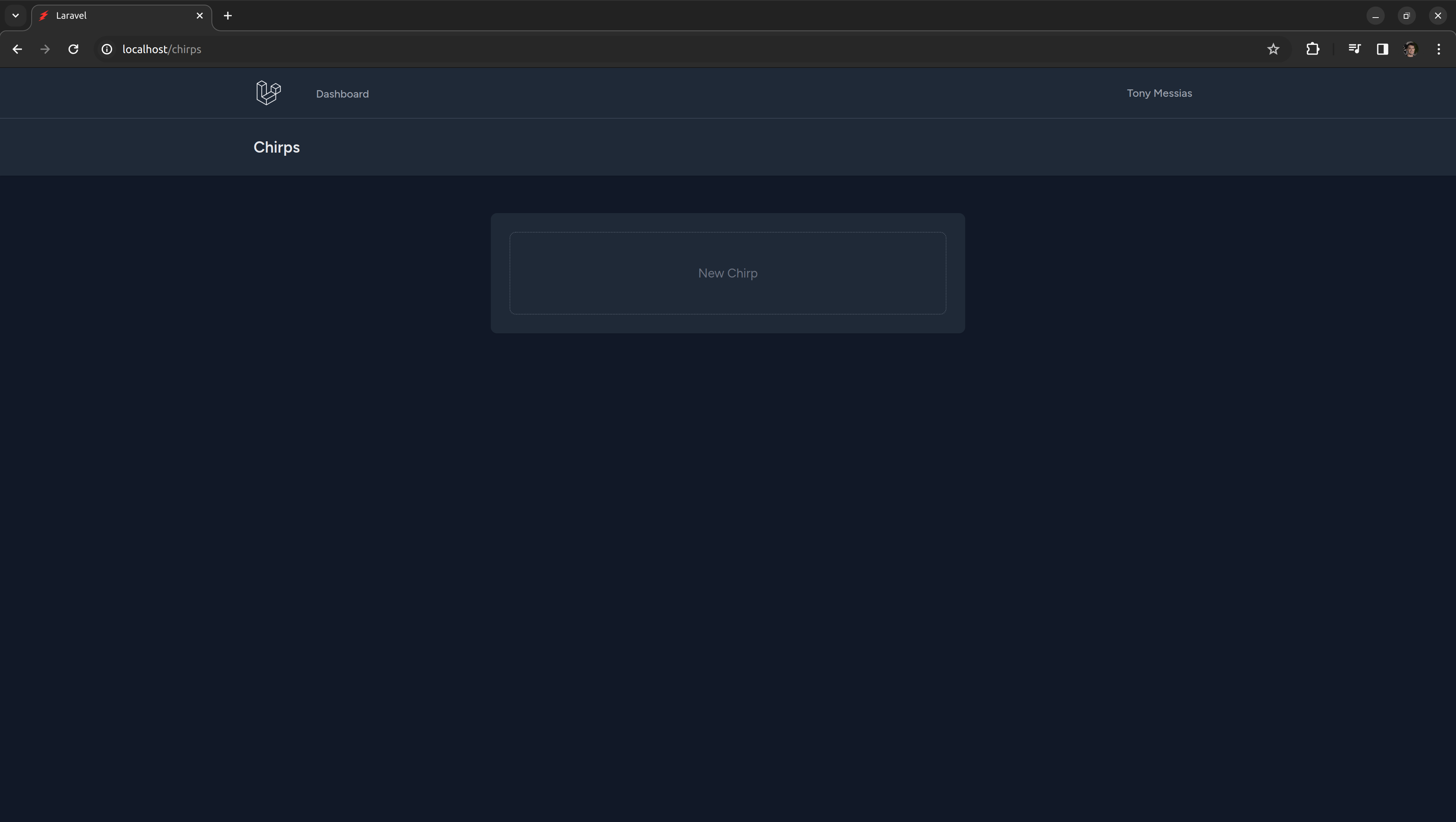
If you click on that link, you will see the form to create Chirps and the breadcrumbs should also have been updated:
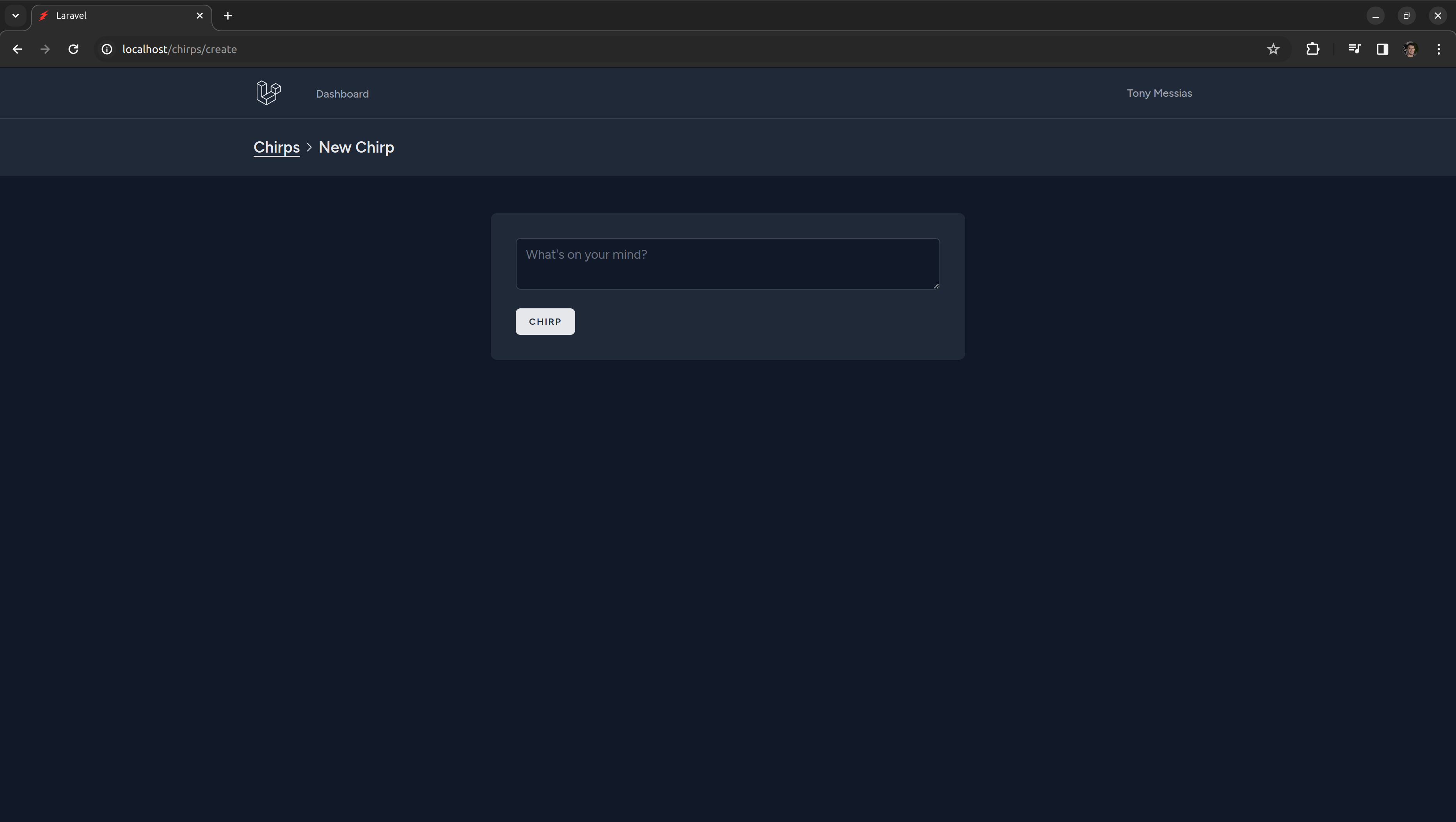
Navigation menu
Let's take a moment to add a link to the navigation menu provided by Turbo Breeze.
Update the navigation partial provided by Turbo Breeze to add a menu item for desktop screens:
<nav data-controller="responsive-nav" data-action=" turbo:before-cache@window->responsive-nav#close click@window->responsive-nav#closeWhenClickedOutside " class="group bg-white dark:bg-gray-800 border-b border-gray-100 dark:border-gray-700"> <!-- Primary Navigation Menu --> <div class="max-w-7xl mx-auto px-4 sm:px-6 lg:px-8"> <div class="flex justify-between h-16"> <div class="flex"> <!-- Logo --> <div class="shrink-0 flex items-center"> <a href="{{ route('dashboard') }}"> <x-application-logo class="block h-9 w-auto fill-current text-gray-800 dark:text-gray-200" /> </a> </div> <!-- Navigation Links --> <div class="hidden space-x-8 sm:-my-px sm:ms-10 sm:flex"> <x-nav-link :href="route('dashboard')" :active="request()->routeIs('dashboard')"> {{ __('Dashboard') }} </x-nav-link> <x-nav-link :href="route('chirps.index')" :active="request()->routeIs('chirps.*')"> {{ __('Chirps') }} </x-nav-link> </div> </div>
<div class="flex items-center space-x-2"> <!-- Settings Dropdown --> <a href="{{ route('profile.index') }}" class="inline-flex items-center px-3 py-2 border border-transparent text-sm leading-4 font-medium rounded-md text-gray-500 dark:text-gray-400 bg-white dark:bg-gray-800 hover:text-gray-700 dark:hover:text-gray-300 focus:outline-none transition ease-in-out duration-150"> <div>{{ Auth::user()->name }}</div> </a> <!-- Hamburger --> <div class="-me-2 flex items-center sm:hidden"> <button data-action="responsive-nav#toggle" class="inline-flex items-center justify-center p-2 rounded-md text-gray-400 dark:text-gray-500 hover:text-gray-500 dark:hover:text-gray-400 hover:bg-gray-100 dark:hover:bg-gray-900 focus:outline-none focus:bg-gray-100 dark:focus:bg-gray-900 focus:text-gray-500 dark:focus:text-gray-400 transition duration-150 ease-in-out"> <svg class="h-6 w-6" stroke="currentColor" fill="none" viewBox="0 0 24 24"> <path class="inline-flex group-data-[responsive-nav-open-value=true]:hidden" stroke-linecap="round" stroke-linejoin="round" stroke-width="2" d="M4 6h16M4 12h16M4 18h16" /> <path class="hidden group-data-[responsive-nav-open-value=true]:inline-flex" stroke-linecap="round" stroke-linejoin="round" stroke-width="2" d="M6 18L18 6M6 6l12 12" /> </svg> </button> </div> </div> </div> </div> <!-- Responsive Navigation Menu --> <div class="hidden group-data-[responsive-nav-open-value=true]:block sm:group-data-[responsive-nav-open-value=true]:hidden"> <div class="pt-2 pb-3 space-y-1"> <x-responsive-nav-link :href="route('dashboard')" :active="request()->routeIs('dashboard')"> {{ __('Dashboard') }} </x-responsive-nav-link> <x-responsive-nav-link :href="route('chirps.index')" :active="request()->routeIs('chirps.*')"> {{ __('Chirps') }} </x-responsive-nav-link> </div> </div></nav>We should see the Chirps link on the page nav now:
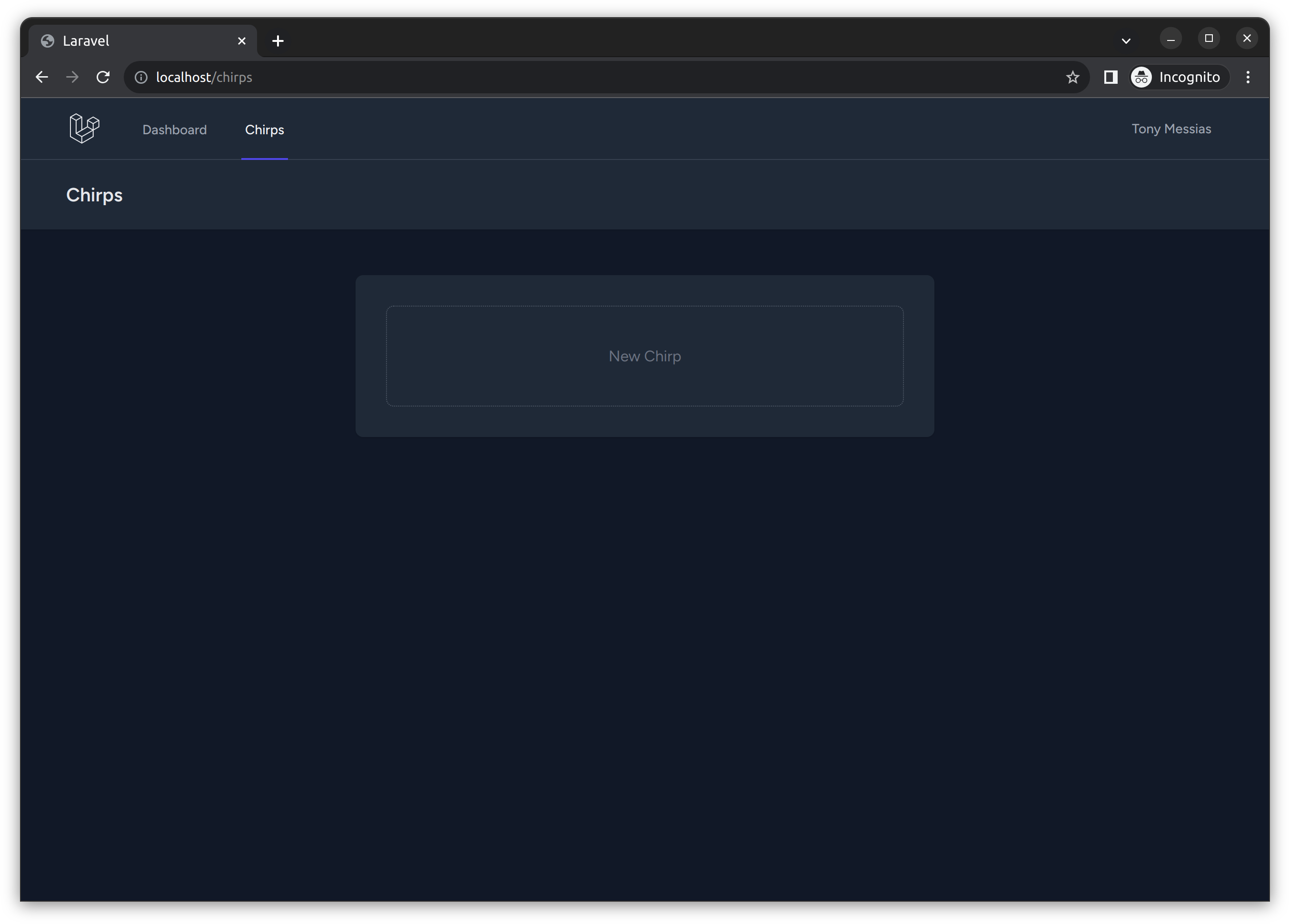
Saving the Chirp
Our form has been configured to post messages to the chirps.store route that we created earlier. Let's update the store action on our ChirpController class to validate the data and create a new Chirp:
<?php
namespace App\Http\Controllers; use App\Models\Chirp;use Illuminate\Http\Request; class ChirpController extends Controller{
/** * Display a listing of the resource. * * @return \Illuminate\Http\Response */ public function index() { return view('chirps.index'); } /** * Show the form for creating a new resource. * * @return \Illuminate\Http\Response */ public function create() { return view('chirps.create'); } /** * Store a newly created resource in storage. * * @param \Illuminate\Http\Request $request * @return \Illuminate\Http\Response */ public function store(Request $request) { // $validated = $request->validate([ 'message' => ['required', 'string', 'max:255'], ]); $request->user()->chirps()->create($validated); return redirect()->route('chirps.index'); }
/** * Display the specified resource. * * @param \App\Models\Chirp $chirp * @return \Illuminate\Http\Response */ public function show(Chirp $chirp) { // } /** * Show the form for editing the specified resource. * * @param \App\Models\Chirp $chirp * @return \Illuminate\Http\Response */ public function edit(Chirp $chirp) { // } /** * Update the specified resource in storage. * * @param \Illuminate\Http\Request $request * @param \App\Models\Chirp $chirp * @return \Illuminate\Http\Response */ public function update(Request $request, Chirp $chirp) { // } /** * Remove the specified resource from storage. * * @param \App\Models\Chirp $chirp * @return \Illuminate\Http\Response */ public function destroy(Chirp $chirp) { // } }We're using Laravel's powerful validation feature to ensure that the user provides a message and that it won't exceed the 255 character limit of the database column we'll be creating.
We're then creating a record that will belong to the logged in user by leveraging a chirps relationship. We will define that relationship soon.
Finally, we can return a redirect response to our chirps.index route.
Creating a relationship
You may have noticed in the previous step that we called a chirps method on the $request->user() object. We need to create this method on our User model to define a "has many" relationship:
<?php
namespace App\Models; // use Illuminate\Contracts\Auth\MustVerifyEmail;use Illuminate\Database\Eloquent\Factories\HasFactory;use Illuminate\Foundation\Auth\User as Authenticatable;use Illuminate\Notifications\Notifiable;use Laravel\Sanctum\HasApiTokens; class User extends Authenticatable{ use HasApiTokens, HasFactory, Notifiable; /** * The attributes that are mass assignable. * * @var array<int, string> */ protected $fillable = [ 'name', 'email', 'password', ]; /** * The attributes that should be hidden for serialization. * * @var array<int, string> */ protected $hidden = [ 'password', 'remember_token', ]; /** * The attributes that should be cast. * * @var array<string, string> */ protected $casts = [ 'email_verified_at' => 'datetime', ]; public function chirps() { return $this->hasMany(Chirp::class); } }Laravel offers many different types of model relationships that you can read more about in the Eloquent Relationships documentation.
Mass assignment protection
Passing all of the data from a request to your model can be risky. Imagine you have a page where users can edit their profiles. If you were to pass the entire request to the model, then a user could edit any column they like, such as an is_admin column. This is called a mass assignment vulnerability.
Laravel protects you from accidentally doing this by blocking mass assignment by default. Mass assignment is very convenient though, as it prevents you from having to assign each attribute one-by-one. We can enable mass assignment for safe attributes by marking them as "fillable".
Let's add the $fillable property to our Chirp model to enable mass-assignment for the message attribute:
<?php
namespace App\Models; use Illuminate\Database\Eloquent\Factories\HasFactory;use Illuminate\Database\Eloquent\Model; class Chirp extends Model{ use HasFactory; protected $fillable = [ 'message', ]; }You can learn more about Laravel's mass assignment protection in the documentation.
Updating the migration
The only thing missing is extra columns in our database to store the relationship between a Chirp and its User and the message itself. Remember the database migration we created earlier? It's time to open that file to add some extra columns:
<?php
use Illuminate\Database\Migrations\Migration;use Illuminate\Database\Schema\Blueprint;use Illuminate\Support\Facades\Schema; return new class extends Migration{ /** * Run the migrations. * * @return void */ public function up() { Schema::create('chirps', function (Blueprint $table) { $table->id(); $table->foreignId('user_id')->constrained()->cascadeOnDelete(); $table->string('message'); $table->timestamps(); }); }
/** * Reverse the migrations. * * @return void */ public function down() { Schema::dropIfExists('chirps'); } };We haven't migrated the database since we added this migration, so let do it now:
php artisan migrateEach database migration will only be run once. To make additional changes to a table, you will need to create another migration. During development, you may wish to update an undeployed migration and rebuild your database from scratch using the php artisan migrate:fresh command.
Testing it out
We're now ready to send a Chirp using the form we just created! We won't be able to see the result yet because we haven't displayed existing Chirps on the page.
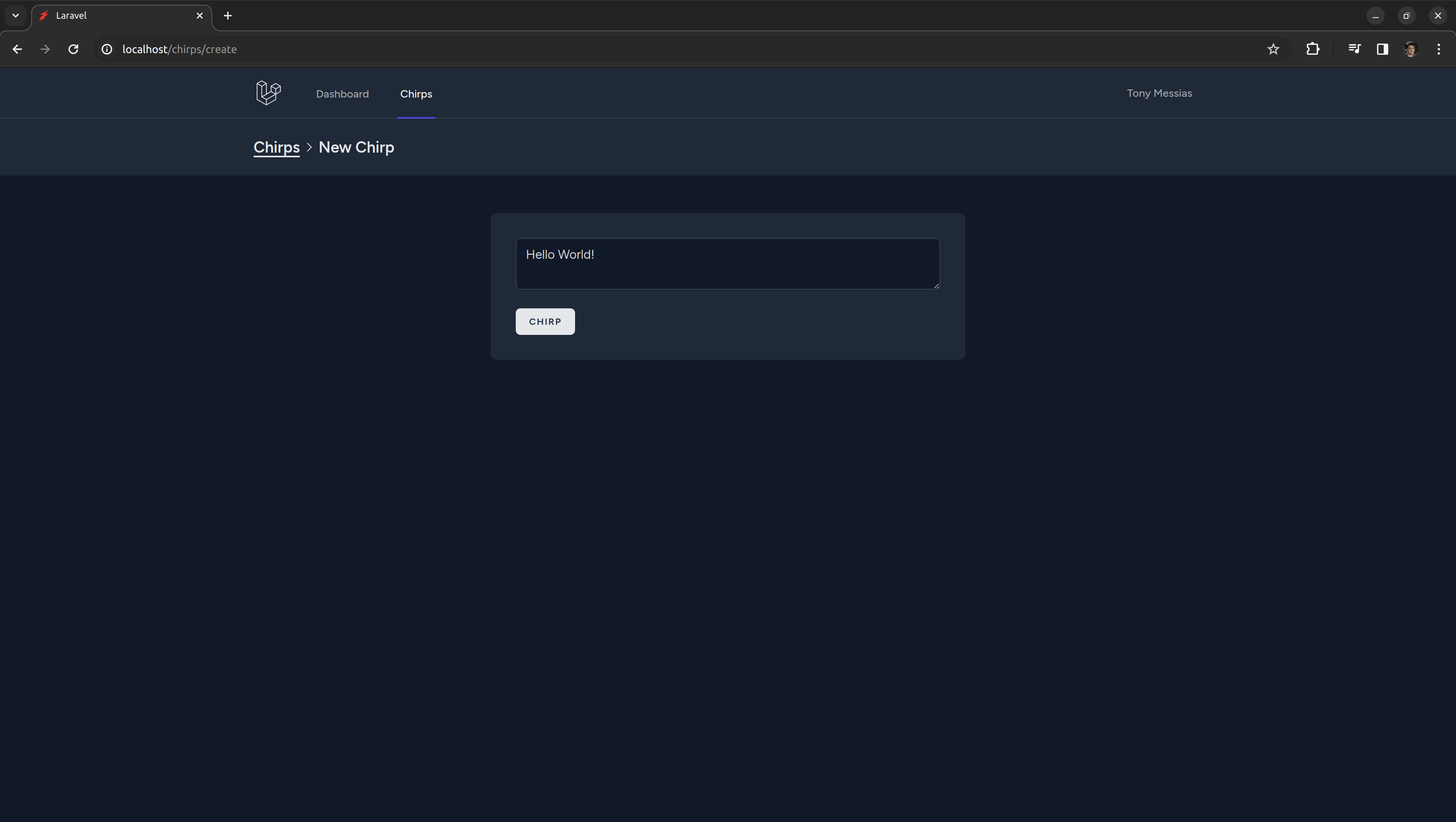
If you leave the message field empty, or enter more than 255 characters, then you'll see the validation in action.
Artisan Tinker
This is great time to learn about Artisan Tinker, a REPL (Read-eval-print loop) where you can execute arbitrary PHP code in your Laravel application.
In your console, start a new tinker session:
php artisan tinkerNext, execute the following code to display the Chirps in your database:
App\Models\Chirp::all();=> Illuminate\Database\Eloquent\Collection {#4634 all: [ App\Models\Chirp {#4636 id: 1, user_id: 1, message: "Hello World!", created_at: "2023-11-26 19:53:33", updated_at: "2023-11-26 19:53:33", }, ], }You may exit Tinker by using the exit command, or by pressing Ctrl + c.
Flash Messages
Before we move on from creating Chirps, let's add the ability to show flash messages to the users. This may be useful to tell them that something happened in our app.
Since we're redirecting the user to another page and redirects happens in the browser (client side), we'd need a way to store messages across requests. Laravel has a feature called Flash Data which does exactly that! With that, we can safely store a flash message in the user's session, just so we can retrive it from there after the redirect happens in the user's browser.
Let's update our store action in the ChirpController to also return a flash message named notice in the redirect:
<?php
namespace App\Http\Controllers; use App\Models\Chirp;use Illuminate\Http\Request; class ChirpController extends Controller{
/** * Display a listing of the resource. * * @return \Illuminate\Http\Response */ public function index() { return view('chirps.index'); } /** * Show the form for creating a new resource. * * @return \Illuminate\Http\Response */ public function create() { return view('chirps.create'); } /** * Store a newly created resource in storage. * * @param \Illuminate\Http\Request $request * @return \Illuminate\Http\Response */ public function store(Request $request) { $validated = $request->validate([ 'message' => ['required', 'string', 'max:255'], ]); $request->user()->chirps()->create($validated); return redirect()->route('chirps.index'); return redirect()->route('chirps.index')->with('notice', __('Chirp created.')); }
/** * Display the specified resource. * * @param \App\Models\Chirp $chirp * @return \Illuminate\Http\Response */ public function show(Chirp $chirp) { // } /** * Show the form for editing the specified resource. * * @param \App\Models\Chirp $chirp * @return \Illuminate\Http\Response */ public function edit(Chirp $chirp) { // } /** * Update the specified resource in storage. * * @param \Illuminate\Http\Request $request * @param \App\Models\Chirp $chirp * @return \Illuminate\Http\Response */ public function update(Request $request, Chirp $chirp) { // } /** * Remove the specified resource from storage. * * @param \App\Models\Chirp $chirp * @return \Illuminate\Http\Response */ public function destroy(Chirp $chirp) { // } }Then, let's change our layouts.app file to include a layouts.partials.notifications partial:
<!DOCTYPE html><html lang="{{ str_replace('_', '-', app()->getLocale()) }}"> <head>
<meta charset="utf-8"> <meta name="viewport" content="width=device-width, initial-scale=1"> <meta name="csrf-token" content="{{ csrf_token() }}"> <title>{{ $title ?? config('app.name', 'Laravel') }}</title> <!-- Fonts --> <link rel="stylesheet" href="https://fonts.bunny.net/css2?family=Nunito:wght@400;600;700&display=swap"> <!-- Scripts --> @vite(['resources/css/app.css', 'resources/js/app.js']) </head> <body class="font-sans antialiased"> <div class="min-h-screen bg-gray-100"> @include('layouts.partials.navigation') @include('layouts.partials.notifications')
<!-- Page Heading --> <header class="bg-white shadow"> <div class="max-w-7xl mx-auto py-6 px-4 sm:px-6 lg:px-8"> {{ $header }} </div> </header> <!-- Page Content --> <main> {{ $slot }} </main> </div> </body></html>Next, let's create the layouts.partials.notifications wrapper partial:
<div id="notifications" class="fixed top-10 left-0 right-0 flex flex-col items-center justify-center space-y-2 z-10 opacity-80"> @if (session()->has('notice')) @include('layouts.partials.notice', ['message' => session('notice')]) @endif</div>So, each notification will render with the layouts.partials.notice (singular) partial and will be added to the wrapper partial. Let's add the indivitual notification partial:
<div data-turbo-temporary data-controller="flash" data-action="animationend->flash#remove" class="py-1 px-4 leading-7 text-center text-white rounded-full bg-gray-900 transition-all animate-appear-then-fade-out"> {{ $message }}</div>There are a few attributes I'd like to briefly discuss here:
- The
data-turbo-temporarytells Turbo to remove this element from the Page Cache - The
data-controller="flash"is how we bind Stimulus controllers to an element. In this case, we're binding theflashcontroller, which is a controller that ships with Turbo Breeze and may be found atresources/js/controllers/flash_controller.js - The
data-action="animationend->flash#remove"is how we add event listeners and invoke Stimulus controller actions when those events happens. In this case, we're listening to a CSS3 event calledanimationendwhich is fired whenever a CSS animation ends. The animation is the one provided by theanimation-appear-then-fade-outCSS class, it also comes from Turbo Breeze.
Now, build our TailwindCSS styles:
php artisan tailwindcss:buildIf you create another Chirp now, you should see a nice notification message at the top:
